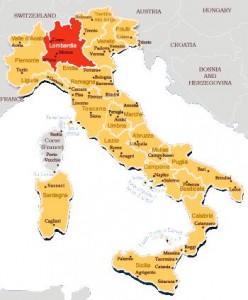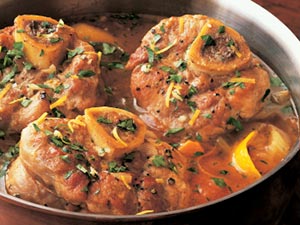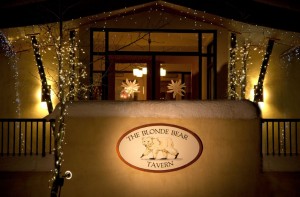.
.
Italians are masters of braising meats, and ossobuco is a perfect example. Take a relatively cheap cut of meat with lots of connective tissue, Braise it until the tough tissues melt, coating the meat fibers, rendering them soft and silky. As with Brasato, the meat will develop a velvety texture and delicious, earthy flavor, but with the added luxury of unctuous bone marrow.
Ossobuco is a centuries-old Lombard recipe of cross-cut veal shanks braised with vegetables, white wine, and broth. It is typically garnished with gremolata, a combination of lemon zest, parsley, and garlic. The most traditional accompaniments to the dish are risotto alla milanese, polenta, or mashed potatoes.
The dish is famous world-wide, and its recipe has been published extensively outside of Italy. It was featured in Henri-Paul Pellaprat’s famous L’Art Culinaire Moderne, published in France in 1935, and the British Italian Food, by Elizabeth David, first published in 1954. The dish has become a part of the French home cooking tradition, known as ossobucco à la milanaise (with added butter (!)
Every January 17th — for the last five years — the Virtual Group of Italian Chefs (GVCI) promotes one authentic Italian recipe on its International Day of Italian Cuisines (IDIC). We were honored to participate the last two years with a couple of Bellavitae signature dishes: Tagliatelle al Ragù Bolognese, and Pesto Genovese. The previous years featured Pasta alla Carbonara and Risotto alla Milanese.
The International Day of Italian Cuisines is born from a mission, as explained by Rosario Scarpato, GVCI Honorary President and last year’s IDIC Director:
“We certainly aim at educating worldwide consumers, but more than anything else, we want to protect their right to get what they pay for when going to eateries labeled as ‘Italian’; that is, authentic and quality Italian cuisine.”
So in celebratory spirit we participate again this year, right here at The Blonde Bear Tavern. Ossobuco is a perfect entree after skiing all day. Come join us this Tuesday, January 17th, for our preparation of ossobuco.
Lombardy – Birthplace of Ossobuco

.
Ossobuco traces its beginnings to Lombardy (“Lombardia” in Italian), and many believe to Milan, although there is some controversy about that. Lombardy is a large region in the north of Italy. The river Po forms a natural boundary in the south, the Alps to the north, with Lakes Garda on the east and Maggiore and Como on the West.

The regional cuisine of Lombardy is based upon ingredients like maize, rice, beef, pork, butter, and lard. Despite being a form of Italian cuisine, Lombard food tends to have little in common with Central or Southern Italian dishes, in many cases lacking the presence of tomato and olive oil, being more meat-based and buttery. In many ways, Lombard cuisine has much in common with that of Austria and much of central Europe in general.
But as Italian cuisine, Lombard food is full of variety and every city and part of the region offers its own specialties. A characteristic Lombard dish is risotto, most famously risotto alla milanese (which is made with saffron), with rice-based food being highly common throughout the region. Similar to risotto, maize-based dishes such as polenta are also common. Other famous Lombard dishes include cotoletta, cassoeula, and of course ossobuco. The region also offers several delicacies and desserts, including mostarda and panettone. Regional cheeses include Robiola, Crescenza, Taleggio, Gorgonzola and Grana Padano.
.
What to drink with Ossobuco
Which wines pair well with Ossobuco? Ask the expert, Luca Gardini, named the world’s best sommelier last year. His recommendations are here.
.
The History of Ossobuco
The word ossobuco (“oss bus” in Milanese dialect) means “bone with a hole” (osso bone, buco hole), a reference to the marrow hole at the center of the cross-cut veal shank.
Milan claims to be the birth city of ossobuco and in 2007, the City Council declared it as part of the De.Co. (Denominazioni Comunali or community denominations), which is an official public acknowledgement that a dish belongs to a certain territory.
The use of marrow bones and veal shanks was common in Middle Age Italian cuisine, but there is no evidence of the presence of ossobuco as a dish at that time. The recipe is believed to have first appeared in Pellegrino Artusi’s cookbook La Scienza in Cucina e l’Arte di Mangiar Bene (The Science in the Kitchen and the Art of Eating Well), the first collection of Italian national cuisine ever published. The book celebrates both home cooking and well-known dishes from all over Italy. These dishes were well-established, indicating the dish had been around for decades, most likely originating in one of the region’s osterie or trattorie.
The Ingredients (for six servings)
For the Ossobuco:
- 4 tablespoons extra virgin olive oil
- 4 tablespoons unsalted butter
- 6 veal shanks, cut 1 ½ inches thick, patted dry and tied tightly around the middle
- Salt and freshly-ground black pepper
- 2 ½ cups dry white wine
- 2 medium onions, cut into ½-inch pieces
- 2 medium carrots, cut into ½-inch pieces
- 2 medium celery ribs, cut into ½-inch pieces
- 2 cups veal or low-sodium chicken broth
- 2 Bay leaves
- 1 14.5-ounce can diced tomatoes
- ¼ cup minced fresh parsley leaves
- 2 teaspoons garlic cloves, chopped very, very fine
- 2 teaspoons grated minced lemon zest
- The best ossobuco is made from the meatier hind leg, so ask your butcher for this cut.
- Have the shanks cut no thicker than 1 ½ inches. Thicker cuts may look impressive, but need to cook longer and slower, otherwise it will end up being stringy and chewy.
- The shanks are better with the skin left on, which helps to keep the ossobuco together while it cooks. Moreover, the creamy consistency of the skin adds a fabulous mouth-feel and flavor to the final dish.
- Veal broth (not stock) is preferable in this dish, but if it’s unavailable, use chicken broth. Beef broth is not optimal here, but you can use a mixture of half beef and half chicken broth.
- Using stock in this recipe (instead of broth) will create disappointing results. Broth is subtler, and will produce an optimum flavor profile. Frankly, stock is never used in Italian cooking; if used in this recipe (with the shank’s bone marrow) will put the dish, well, over the top.
- Sometime during the 1960s or ’70s, cooks began dredging the shanks in flour before browning. I don’t particularly like this method, and find that the elimination of the technique produces a better flavor. But it’s still authentic to do so.
Preparing Ossobuco
Preheat the oven to 325°F and adjust the rack to the lower middle portion, so the Dutch oven will rest in the middle of the oven.
- Heat 1 tablespoon of the oil and 1 tablespoon of the butter in a large Dutch oven over medium heat. Season both sides of the veal shanks with salt and pepper
- Place 3 of the shanks in the pan and cook until they are golden on one side, about 6 minutes. Guild the other side of the shanks, about 6 minutes longer.
- Remove shanks from Dutch oven and place in a bowl. Off heat, add ½ cup of the white wine to the Dutch oven, scraping the bottom with a wooden spoon. Pour the liquid into the bowl of shanks.
- Return the Dutch oven to medium heat and repeat the process with the remaining 3 shanks, guilding both sides in the same amount of olive oil and butter, then placing them with the original 3 shanks. De-glaze the Dutch oven again using 1 more cup of white wine. Pour the liquid over the six shanks.
- Return the Dutch oven to medium heat and add the remaining olive oil and butter. Saute the onion until translucent. Then add the celery and Bay leaf and cook for an additional 3 to 5 minutes. Finally, add the carrot and cook for another 3 to 5 minutes, stirring occasionally.
- Increase the heat to high and add the broth and remaining 1 cup of wine. Add the tomatoes. Return the veal shanks to the pot, arranging in a single, tight layer. Ensure the open end (or larger opening) of each bone is facing up so the marrow doesn’t fall out during braising. The liquid should just cover the shanks – if not, add more broth. If there is too much liquid, remove some with a spoon.
- Bring the liquid to a simmer, then cover the pot and transfer it to the oven. Cook the shanks until the meat is easily pierced with a fork, but not falling off the bone, about 2 hours.
- Combine the parsley, garlic, and lemon zest.
- Stir half of the gremolata in the pot, reserving the balance for garnish. Let the ossobuco stand for 5 minutes, uncovered.
.
- Remove the shanks from the pot, remove the twine, and place each shank in a bowl, perhaps over polenta.
- Ladle some braising liquid over each shank, and sprinkle the gremolata over each serving.
.
Related:
- The Italian Flavor Base: Battuto, Soffritto, Trito
- Mastering the Techniques of Sautéing and Browning
- Ricette Classiche: Brasato al Barolo
- Italian Luca Gardini Named World’s Best Sommelier
.
Further Reading:
- The Official Dish of the IDIC 2012: Ossobuco in Gremalta alla Milanese
- The Italian Academy of Cuisine: La Cucina, The Regional Cooking of Italy
- Official Site: Milan
- Official Site: Lombardia
- Cooking for Engineers: Recipe File: Ossobuco
Ossobuco, the perfect winter dish, most satisfying after a vigorous run down the mountain. Too tired to make it yourself? Join us and hundreds of other chefs around the world on January 17th. Enjoy this famous dish, evolved over centuries, right here at The Blonde Bear Tavern.
.



1 thought on “Ricette Classiche: Ossobuco in Gremolata alla Milanese”